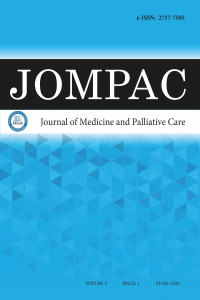Abstract
Rhino-orbito-cerebral Mucormycosis is an opportunistic fungal infection caused by Zygomycetes species mold fungi with a high mortality and morbidity rate. The most important risk factor for Mucormycosis is uncontrolled diabetes and diabetic ketoacidosis. Except this; desferoxamine treatment, high iron, immunosuppressive drugs, corticosteroid use are other risk factors. In this article, a 62-year-old diabetic man who developed vision loss and cerebral abscess due to late diagnosed rhinocerebral Mucormycosis was presented. The patient was treated with liposomal amphotericin-B with surgical debridement.
Project Number
-
References
- Kara M, Erdogan H, Toroslu T, et al. Rhino-orbito-cerebral Mucormycosis: two case reports in the light of the literature. Kulak Burun Bogasz İhtis Derg 2015; 25: 295-301.
- Sundaram C, Mahadevan A, Laxmi V, et al. Cerebral zygomycosis. Mycoses 2005; 48: 396-407.
- Tatar EC,Sürenoğlu UA, Işık E, Tütüncü E, Korkmaz H. Rhino-orbital Mucormycosis with orbital abscess : a case report. Kulak Burun Bogaz İhtis Derg 2011; 21: 102-5.
- Binder U, Maurer E, Flörl CL. Mucormycosis--from the pathogens to the disease. Clin Microbiol Infect 2014; 20: 60-6.
- Chayakulkeeree M, Ghannoum MA, Perfect JR. Zygomycosis: the re-emerging fungal infection. Eur J Clin Microbiol Infect Dis 2006; 25: 215-29.
- Günaydın S, Baştan B, Acar H, Çevik N, Çokar Ö. Tolosa-Hunt sendromu: iki olgu sunumu. Med Bull Haseki 2015; 53: 308-12.
- Bačová E, Chovanec F, Makohusová M, et al. Invasive rhino-orbito-cerebral Mucormycosis in pediatric patient with acute leukemia. Klin Onkol Spring 2020; 33: 138-44.
- Roden MM , Zaoutis TE, Buchanan WL, et al. Epidemiology and outcome of zygomycosis: a review of 929 reported cases. Clin Infect Dis 2005; 1: 634-53.
- Petrikkos G, Skiada A, Lortholary O, Roilides E, Walsh TJ, Kontoyiannis DP. Epidemiology and clinical manifestations of Mucormycosis. Clin Infect Dis 2012; 54: S23-34.
- Guerreiro CA, Nobrega JP, Carvalho MP. Orbito-rhino-cerebral phycomycosis (Mucormycosis): report of a case. Arq Neuropsiquiatr 1980; 38: 99-105.
Abstract
Rino-orbito-serebral mukormikozis, Zygomycetes türü küf mantarlarının neden olduğu, mortalitesi ve morbidite oranı yüksek fırsatçı bir mantar enfeksiyonudur. Mukormikozis için en önemli risk faktörü kontrolsüz diyabet ve diyabetik ketoasidozdur. Bunun dışında; desferoksamin tedavisi, demir yüksekliği, immünosüpresif ilaçlar, kortikosteroid kullanımı diğer risk faktörleridir. Bu yazıda, geç tanı konulan rinoorbitoserebral mukormikozise bağlı olarak görme kaybı ve serebral apse gelişen 62 yaşında diyabetik bir erkek sunuldu. Hastaya cerrahi debridman ile birlikte lipozomal amfoterisin-B tedavisi uygulandı.
Supporting Institution
-
Project Number
-
Thanks
-
References
- Kara M, Erdogan H, Toroslu T, et al. Rhino-orbito-cerebral Mucormycosis: two case reports in the light of the literature. Kulak Burun Bogasz İhtis Derg 2015; 25: 295-301.
- Sundaram C, Mahadevan A, Laxmi V, et al. Cerebral zygomycosis. Mycoses 2005; 48: 396-407.
- Tatar EC,Sürenoğlu UA, Işık E, Tütüncü E, Korkmaz H. Rhino-orbital Mucormycosis with orbital abscess : a case report. Kulak Burun Bogaz İhtis Derg 2011; 21: 102-5.
- Binder U, Maurer E, Flörl CL. Mucormycosis--from the pathogens to the disease. Clin Microbiol Infect 2014; 20: 60-6.
- Chayakulkeeree M, Ghannoum MA, Perfect JR. Zygomycosis: the re-emerging fungal infection. Eur J Clin Microbiol Infect Dis 2006; 25: 215-29.
- Günaydın S, Baştan B, Acar H, Çevik N, Çokar Ö. Tolosa-Hunt sendromu: iki olgu sunumu. Med Bull Haseki 2015; 53: 308-12.
- Bačová E, Chovanec F, Makohusová M, et al. Invasive rhino-orbito-cerebral Mucormycosis in pediatric patient with acute leukemia. Klin Onkol Spring 2020; 33: 138-44.
- Roden MM , Zaoutis TE, Buchanan WL, et al. Epidemiology and outcome of zygomycosis: a review of 929 reported cases. Clin Infect Dis 2005; 1: 634-53.
- Petrikkos G, Skiada A, Lortholary O, Roilides E, Walsh TJ, Kontoyiannis DP. Epidemiology and clinical manifestations of Mucormycosis. Clin Infect Dis 2012; 54: S23-34.
- Guerreiro CA, Nobrega JP, Carvalho MP. Orbito-rhino-cerebral phycomycosis (Mucormycosis): report of a case. Arq Neuropsiquiatr 1980; 38: 99-105.
Details
| Primary Language | Turkish |
|---|---|
| Subjects | Health Care Administration |
| Journal Section | Case Report [en] Olgu Sunumu [tr] |
| Authors | |
| Project Number | - |
| Publication Date | March 24, 2022 |
| Published in Issue | Year 2022 Volume: 3 Issue: 1 |
TR DİZİN ULAKBİM and International Indexes (1d)
Interuniversity Board (UAK) Equivalency: Article published in Ulakbim TR Index journal [10 POINTS], and Article published in other (excuding 1a, b, c) international indexed journal (1d) [5 POINTS]
|
|
|
Our journal is in TR-Dizin, DRJI (Directory of Research Journals Indexing, General Impact Factor, Google Scholar, Researchgate, CrossRef (DOI), ROAD, ASOS Index, Turk Medline Index, Eurasian Scientific Journal Index (ESJI), and Turkiye Citation Index.
EBSCO, DOAJ, OAJI and ProQuest Index are in process of evaluation.
Journal articles are evaluated as "Double-Blind Peer Review".










